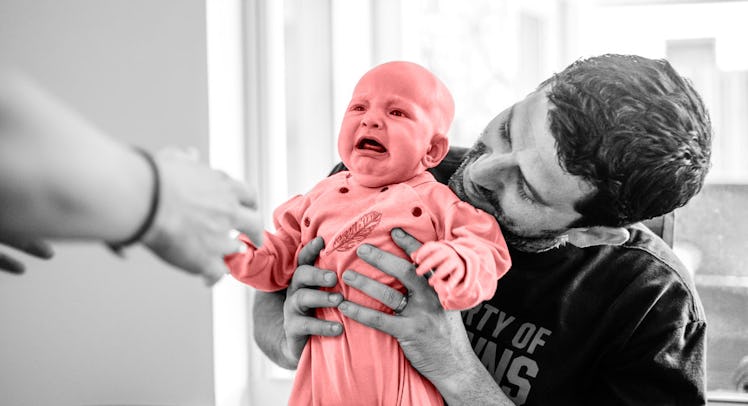How to Prepare a Baby for Daycare and Stop the Crying Before It Starts
The daycare handoff shouldn't come as a surprise.

In America, daycare is an expensive norm for parents unless they have financial independence or stay at home. That means that whether parents opt for a baby daycare facility or a child care center, their baby will go through a transition from parental supervision to the care of a stranger. They will cry and parents will be stymied by how to stop a baby from crying. That sounds tough for all concerned, and in truth, it can be. However, preparation is key. So is routine.
“The first day that an infant will be away from a parent is usually a foreseeable event,” explains Dr. Jack Maypole, associate professor of pediatrics at Boston University School of Medicine, and member of the Goddard School’s Educational Advisory Board. That means parents have time to prepare.
The first day of baby daycare shouldn’t be the first day mom and dad leave the baby with someone else. Leaving the baby with a sitter for an hour or two to run errands does more than give a parent the chance to interact with other grown-ups. It helps identify potential problems and conditions the kid, demonstrating that mom and dad will come home (though this isn’t exactly critical as babies can’t remember much anyway).
How to Make the Daycare Transition Easier
- Try it out – Leaving for short trips can help reveal weaknesses in a family’s transition game and, depending on the age of the baby, show that mommy and daddy DO come home.
- Bank milk ahead of time – Pumping parents may already have a stock of milk on hand, but it’s always better to have a little extra on hand for the caregiver than too little.
- Make the goodbyes quick – Say goodbye with all the sweetness a baby deserves, but then actually make it goodbye. Lingering and returning can be confusing to both baby and caregiver.
After a few daytime runs, mom and dad can try leaving the baby in daycare. Again, these should be short test runs — no more than an hour, with pick-up times clearly communicated with the caregiver and an adequate amount of milk or formula supplied. This helps give both parents and the caregiver an idea of how that first day will go, though it may be too tricky to have the baby nap during these short runs.
Breastfeeding is also a concern. “Bank milk as far in advance as possible and provide an ample supply to your child care provider,” advises Dr. Maypole. The amount will vary according to the baby’s age but as an example, most 4-month-olds will drink four to six ounces every three to four hours.
RELATED: How Much Does Daycare Really Cost?
If parents aren’t already supplementing their baby’s diet with formula, it might be something to consider starting; it’s good to have an ample supply of nutrition on hand for the caregiver and sometimes pumping alone can’t produce the volume needed.
When that fateful baby daycare day comes, make the goodbye short and sweet, recommends Dr. Maypole. “Lingering goodbyes are more for the parent than the baby,” he says. Separation anxiety is often worse for parents than for kids. That’s because as long as their routines and schedules stay about the same, babies may not particularly notice when a parent leaves. That might feel weird, but it’s for the best to recognize it for the blessing that it is, kiss the kid, and head into the office.
This article was originally published on